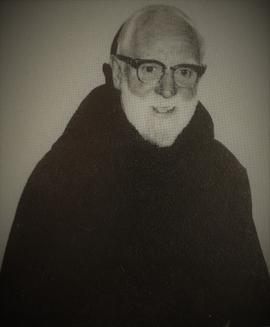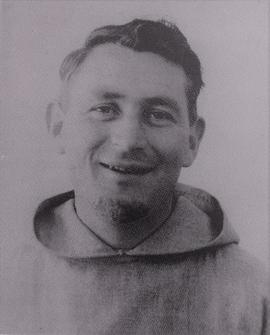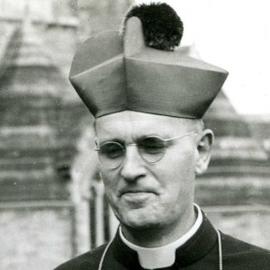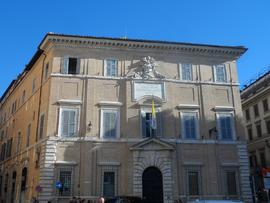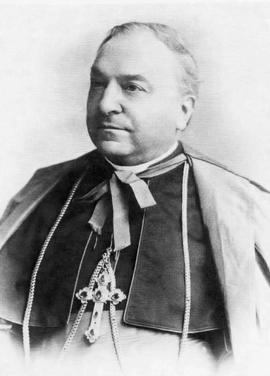Baptismal name: Timothy Cooney
Religious name: Br. Eolan Cooney OFM Cap.
Date of birth: 14 Sept. 1913
Place of birth: Rylane, County Cork (Diocese of Cloyne)
Name of father: Timothy Cooney (Labourer)
Name of mother: Julia Cooney (née Rourke)
Date of parents’ marriage: 21 Sept. 1905
Date of reception into the Capuchin Order: 12 Nov. 1934
Date of first profession: 13 Nov. 1935
Date of final profession: 12 Nov. 1938
Date of death: 29 July 1999
Place of death: Nursing home, Mount Desert, Cork
Place of burial: Cemetery, Rochestown Capuchin Friary, County Cork
Thomas Joseph Prendiville was born in Ballymacelligott in County Kerry on 27 November 1924. His early education was in the local national school and later at the Capuchin College in Rochestown, County Cork. He joined the Capuchin Franciscans in October 1944 and took Bartholomew as his religious name. He obtained a BA degree in philosophy from University College Cork in 1948. He completed his theological studies in Ard Mhuire Friary in County Donegal and was ordained to the priesthood on 12 June 1952. He returned to St. Bonaventure’s Friary in Cork and obtained a Higher Diploma in Education (UCC) before travelling to Norther Rhodesia (now Zambia) for missionary work in 1953. He spent eighteen years in Zambia. In 1971 he was transferred to the Cape Town mission in South Africa. His years in Zambia mainly involved work in the education sector, first as a manager of schools at several mission stations, and later as education secretary in Livingstone. In South Africa, he served as parish priest in several churches in various Cape Town suburbs including Langa, Belgravia and Parow. He served as consultor to the Regular Superior of the Cape Town mission on two occasions (1971-4; 1974-7). He was elected Regular Superior in 1977 and held this position until 1983. He died in Parow, Cape Town, on 7 July 2004 and was buried in Maitland Cemetery.
Baptismal name: Thomas Joseph Prendiville
Religious name: Fr. Bartholomew Prendiville OFM Cap.
Date of birth: 27 Nov. 1924
Place of birth: Ballymacelligott, County Kerry
Name of father: Michael Prendiville
Name of mother: Hanora Prendiville (née Scanlon)
Date of reception into the Capuchin Order: 3 Oct. 1944
Date of first profession: 4 Oct. 1945
Date of final profession: 4 Oct. 1948
Date of ordination (as priest): 12 June 1952
Educational attainments: BA (1948); Higher Diploma in Education (1953)
Missionary activities: Travelled to Livingstone, Northern Rhodesia (later Zambia) on 26 Aug. 1953. He was transferred to Cape Town, South Africa, on 12 May 1971.
Leadership positions: Regular Superior, Cape Town Mission, South Africa, 1977-83
Date of death: 7 July 2004
Place of death: Parrow, Cape Town, South Africa
Place of burial: Maitland Cemetery, Cape Town, South Africa
John Joseph Gleeson was born in Cork on 28 October 1910. He received his initial education with the Christian Brothers and later at the Capuchin College in Rochestown in County Cork. He joined the Order in November 1929 and took Richard as his religious name. After completing his novitiate, he graduated with a BA degree in philosophy and advanced to his theological studies. He was ordained to the priesthood at Ard Mhuire Capuchin Friary in County Donegal on 27 June 1937. Shortly afterwards, he was transferred to the American mission custody. He was initially assigned to St. Patrick’s Friary in Wilmington, Delaware, where he gave numerous missions, retreats, and novenas. He was also frequently chosen as the homilist at Requiem Masses for deceased friars. He worked as associate pastor, as vice novice master and teacher, and as guardian and pastor. Later in his life, he ministered in Capuchin foundations in California (Fort Bragg, Burlingame, and La Cañada Flintridge) and in Oregon (Roseburg and Bend). His health began to decline in the late 1950s and he was transferred to Our Lady of Angels Parish in Burlingame. He died on 18 June 1976 and was buried in the cemetery attached to San Lorenzo Seminary, Santa Inés, California.
Baptismal name: John Joseph Gleeson
Religious name: Fr. Richard Gleeson OFM Cap.
Date of birth: 28 Oct. 1910
Place of birth: 50 Evergreen Street, Cork
Name of father: Joseph Gleeson
Name of mother: Nora Gleeson (née O’Leary)
Date of reception into the Capuchin Order: 1 Nov. 1929
Date of first profession: 2 Nov. 1930
Date of final profession: 2 Nov. 1933
Educational attainments: BA, 2nd class hons. (1933)
Date of ordination (as priest): 27 June 1937 (Ard Mhuire Friary, County Donegal)
Missionary activities: Travelled to the United States mission in 1937
Date of death: 18 June 1976
Place of death: Burlingame, California
Place of burial: Cemetery, San Lorenzo Seminary, Santa Inés, California
Patrick Francis Gaynor was born in Carrick-on-Suir in County Tipperary on 17 May 1925. He received his primary and secondary education at the local Christian Brothers’ school. He entered the Capuchin novitiate at Rochestown in County Cork on 3 October 1944. He took Barnabas as his religious name upon joining the Order. He obtained a BA degree from University College Cork in 1948 and then proceeded to Ard Mhuire Friary in County Donegal for his theological studies. He was ordained to the priesthood on 12 June 1952. He served as assistant master of novices in Rochestown Friary until July 1953 when he moved to Kilkenny where he served as a questor for five years. In 1958 he was transferred to the Church Street Friary in Dublin. He taught religion in various vocational schools for ten years. He attended University College Dublin from 1971 to 1973 and was awarded a Higher Diploma in Education and later a Diploma in Counselling and Career Guidance. He also held the position of Provincial Bursar for two years. A posting to Cape Town in South Africa for missionary work was cut short due to medical issues and he returned to the Church Street Friary in Dublin. He continued to be active in ministry (particularly with the Secular Franciscan Organisation and Padre Pio prayer groups) until his death on 14 May 2001. He was buried in the Capuchin plot in Dardistown Cemetery in County Dublin.
Baptismal name: Patrick Francis Gaynor
Religious name: Fr. Barnabas Gaynor OFM Cap.
Date of birth: 17 May 1925
Place of birth: Carrick-on-Suir, County Tipperary (Diocese of Waterford & Lismore)
Name of father: Michael Gaynor
Name of mother: Margaret Gaynor (née Guiry)
Date of reception into the Capuchin Order: 3 Oct. 1944
Date of first profession: 4 Oct. 1945
Date of final profession: 4 Oct. 1948
Date of ordination (as priest): 12 June 1952
Educational attainments: BA, 2nd class hons. (1948); Higher Diploma in Education (1973)
Date of death: 14 May 2001
Place of death: Sacred Heart Residence, Sybil Hill Nursing Home, Dublin
Place of burial: Dardistown Cemetery, Dublin
Baptismal name: David Matthew Carew
Religious name: Fr. Andrew Carew OFM Cap.
Date of birth: 20 Oct. 1902
Place of birth: Ballydavid, Templeneiry, Bansha, County Tipperary
Name of father: William Carew (Farmer)
Name of mother: Mary Carew
Date of reception into the Capuchin Order: 18 Sept. 1921
Date of first profession: 15 Oct. 1922
Date of final profession: 29 Dec. 1925
Date of ordination (as priest): 29 July 1928 (Rome)
Educational attainments: BA, 1st class hons. (1925); Doctor of Divinity (Rome), (1929)
Leadership positions: Guardian, Ard Mhuire Friary, County Donegal, 1943-52; Guardian, Rochestown Friary, County Cork, 1964-7; Mission Secretary for nine years
Date of death: 2 Dec. 1987
Place of death: Kilkenny
Place of burial: Foulkstown Cemetery, County Kilkenny
John Joseph Carroll was born near Nenagh in County Tipperary on 15 February 1903. He joined the Capuchin Franciscans in September 1921 and took Finian as his religious name. Having completed his philosophical and theological studies, he was ordained to the priesthood on 29 June 1929. Shortly afterwards, he volunteered for missionary work in the United States. His first assignment was in the Parish of St. Mary of the Angels in Ukiah, California. He remained assistant pastor in Ukiah until 1933 when he was assigned to Our Lady of Angels Parish in Burlingame, California. In August 1939 he was appointed pastor of Blessed Sacrament Parish in Elk, California. In the following years he had many assignments, moving between California and Oregon and ministering in various Capuchin foundations. From July 1939 to July 1943, he was pastor at Mission Santa Inés, Solvang, California. He then moved to St. Joseph’s Parish in Roseburg, Oregon (1943-4). From 1944 to 1950, he was assistant pastor in Ukiah California. He then served as custodian at the Capuchin Friary in McKenzie Ridge, Oregon (1950-2). In 1952 he was appointed pastor of Our Lady of Good Counsel Parish in Fort Bragg, California. Here he was successful in building a new church and rectory and relocating the parish hall to the new property. In 1956 he moved to the Parish of St. Francis of Assisi in Los Angeles and was appointed pastor. He immediately began raising funds for the construction of a new church. By the time he retired from the parish in 1964, the new church was completed and was open for services. In 1969 he was transferred to Mission Santa Inés in California. This was to be his last appointment as his health had begun to decline. In September 1971, he returned to Ireland to celebrate his Golden Jubilee as Capuchin Franciscan friar. He suffered a heart attack on 16 September 1971 in Nenagh, County Tipperary. He was buried in the Capuchin plot in Foulkstown Cemetery in County Kilkenny.
Baptismal name: John Joseph Carroll
Religious name: Fr. Finian Carroll OFM Cap.
Date of birth: 15 Feb. 1903
Place of birth: Belleen, Nenagh, County Tipperary (Diocese of Killaloe)
Name of father: Hugh Carroll
Name of mother: Julia Carroll (née Slattery)
Date of reception into the Capuchin Order: 18 Sept. 1921
Date of first profession: 15 Oct. 1922
Date of final profession: 29 Dec. 1925
Educational attainments: BA (NUI), 1925
Date of ordination (as priest): 29 June 1929
Missionary activities: Travelled to the American mission custody in 1929
Date of death: 17 Sept. 1971
Place of death: Nenagh, County Tipperary
Place of burial: Foulkstown Cemetery, County Kilkenny
Bishop James Moynagh S.P.S. (1903–1985), was an Irish-born Roman Catholic priest who served for the Saint Patrick’s Society for the Foreign Missions in Nigeria, and was ordained Bishop of Calabar.
The Sacred Congregation de Propaganda Fide, whose official title is "sacra congregatio christiano nomini propagando" is the department of the pontifical administration charged with the spread of Catholicism and with the regulation of ecclesiastical affairs in non-Catholic countries. The intrinsic importance of its duties and the extraordinary extent of its authority and of the territory under its jurisdiction have caused the cardinal prefect of Propaganda to be known as the "red pope".
Pietro Gasparri, GCTE (5 May 1852 – 18 November 1934) was a Roman Catholic cardinal, diplomat and politician in the Roman Curia and the signatory of the Lateran Pacts. He served also as Cardinal Secretary of State under Popes Benedict XV and Pope Pius XI. - Wikipedia https://en.wikipedia.org/wiki/Pietro_Gasparri
